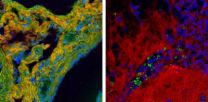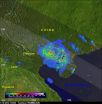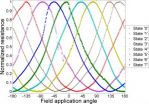(Press-News.org) A research team from the National Institute of Standards and Technology (NIST), working with the Cleveland Clinic, has demonstrated a dramatically improved technique for analyzing biological cells and tissues based on characteristic molecular vibration "signatures." The new NIST technique is an advanced form of the widely used spontaneous Raman spectroscopy, but one that delivers signals that are 10,000 times stronger than obtained from spontaneous Raman scattering, and 100 times stronger than obtained from comparable "coherent Raman" instruments, and uses a much larger portion of the vibrational spectrum of interest to cell biologists.*
The technique, a version of "broadband, coherent anti-Stokes Raman scattering" (BCARS), is fast and accurate enough to enable researchers to create high-resolution images of biological specimens, containing detailed spatial information on the specific biomolecules present at speeds fast enough to observe changes and movement in living cells, according to the NIST team.
Raman spectroscopy is based on a subtle interplay between light and molecules. Molecules have characteristic vibration frequencies associated with their atoms flexing and stretching the molecular bonds that hold them together. Under the right conditions, a photon interacting with the molecule will absorb some of this energy from a particular vibration and emerge with its frequency shifted by that frequency—this is "anti-Stokes scattering." Recording enough of these energy-enhanced photons reveals a characteristic spectrum unique to the molecule. This is great for biology because in principle it can identify and distinguish between many complex biomolecules without destroying them and, unlike many other techniques, does not alter the specimen with stains or fluorescent or radioactive tags.
Using this intrinsic spectral information to map specific kinds of biomolecules in an image is potentially very powerful, but the signal levels are very faint, so researchers have worked for years to develop enhanced methods for gathering these spectra.** "Coherent" Raman methods use specially tuned lasers to both excite the molecular vibrations and provide a bright source of probe photons to read the vibrations. This has partially solved the problem, but the coherent Raman methods developed to date have had limited ability to access most of the available spectroscopic information.
Most current coherent Raman methods obtain useful signal only in a spectral region containing approximately five peaks with information about carbon-hydrogen and oxygen-hydrogen bonds. The improved method described by the NIST team not only accesses this spectral region, but also obtains excellent signal from the "fingerprint" spectral region, which has approximately 50 peaks—most of the useful molecular ID information.
The NIST instrument is able to obtain enhanced signal largely by using excitation light efficiently. Conventional coherent Raman instruments must tune two separate laser frequencies to excite and read different Raman vibration modes in the sample. The NIST instrument uses ultrashort laser pulses to simultaneously excite all vibrational modes of interest. This "intrapulse" excitation is extremely efficient and produces its strongest signals in the fingerprint region. "Too much light will destroy cells," explains NIST chemist Marcus Cicerone, "So we've engineered a very efficient way of generating our signal with limited amounts of light. We've been more efficient, but also more efficient where it counts, in the fingerprint region."
Raman hyperspectral images are built up by obtaining spectra, one spatial pixel at a time. The hundred-fold improvement in signal strength for the NIST BCARS instrument makes it possible to collect individual spectral data much faster and at much higher quality than before—a few milliseconds per pixel for a high-quality spectrum versus tens of milliseconds for a marginal quality spectrum with other coherent Raman spectroscopies, or even seconds for a spectrum from more conventional spontaneous Raman instruments. Because it's capable of registering many more spectral peaks in the fingerprint region, each pixel carries a wealth of data about the biomolecules present. This translates to high-resolution imaging within a minute or so whereas, notes NIST electrical engineer Charles Camp, Jr., "It's not uncommon to take 36 hours to get a low-resolution image in spontaneous Raman spectroscopy."
"There are a number of firsts in this paper for Raman spectroscopy," Camp adds. "Among other things we show detailed images of collagen and elastin—not normally identified with coherent Raman techniques—and multiple peaks attributed to different bonds and states of nucleotides that show the presence of DNA or RNA."
INFORMATION:
*C.H. Camp Jr., Y.J. Lee, J.M. Heddleston, C.M. Hartshorn, A.R. Hight Walker, J.N. Rich, J.D. Lathia and M.T. Cicerone. High-speed coherent Raman fingerprint imaging of biological tissues. Nature Photonics, Published online July 20, 2014. doi:10.1038/nphoton.2014.145.
**See for example the 2010 Tech Beat story, "Faster CARS, Less Damage: NIST Chemical Microscopy Shows Potential for Cell Diagnostics" at http://www.nist.gov/public_affairs/tech-beat/tb20101013.cfm#cars.
Enhanced NIST instrument enables high-speed chemical imaging of tissues
2014-07-22
ELSE PRESS RELEASES FROM THIS DATE:
NASA's TRMM satellite measures up Super Typhoon Rammasun
2014-07-22
NASA's TRMM satellite measured up Super Typhoon Rammasun's rainfall rates, rainfall totals and cloud heights providing a look at the inner workings and aftermath of the storm.
Super Typhoon Rammasun struck the southern coast of China on Friday, July 18 as a very powerful super typhoon with sustained winds estimated at 135 knots (~155 mph or equivalent to a Category 5 hurricane on the US Saffir-Simpson scale), making it the strongest typhoon to hit the area in several decades.
Rammasun made landfall at 3:30 p.m. (local time) on Hainan Island where the southern half of ...
Preschoolers can reflect on what they don't know
2014-07-22
Contrary to previous assumptions, researchers find that preschoolers are able to gauge the strength of their memories and make decisions based on their self-assessments. The study findings are published in Psychological Science, a journal of the Association for Psychological Science.
"Previously, developmental researchers assumed that preschoolers did not introspect much on their mental states, and were not able to reflect on their own uncertainty when problem solving," says psychological scientist Emily Hembacher of the University of California, Davis, lead author of ...
Extra exercise helps depressed smokers kick the habit faster
2014-07-22
This news release is available in French. Montreal, July 22, 2014 — People diagnosed with depression need to step out for a cigarette twice as often as smokers who are not dealing with a mood disorder. And those who have the hardest time shaking off the habit may have more mental health issues than they are actually aware of.
Those insights were among the collective findings recently published in the journal Nicotine & Tobacco Research by a team of researchers based in part at Concordia University.
While nearly one in five North American adults are regular smokers, ...
CEOs who motivate with 'fightin' words' shoot themselves in the foot
2014-07-22
Heading into the war room to fire up the troops? Declaring war on the competition to boost sales? Well, CEO, you might want to tamp down them's fightin' words—you could be shooting yourself in the foot.
A new Brigham Young University business study finds that bosses who try to motivate their employees with violent rhetoric—think of Steve Jobs declaring "thermonuclear war" on Samsung—end up motivating rival employees to play dirty.
"Business executives use violent language all the time," said David Wood, BYU professor of accounting and one of two BYU authors on the paper. ...
Dangers of desert dust: New diagnostic tool for valley fever
2014-07-22
VIDEO:
In this video, biodesign researcher Krupa Navalkar describes a new diagnostic technique for pinpointing Valley Fever.
Click here for more information.
On July 5, 2011, a massive wall of dust, ("haboob," in Arabic), blanketed Phoenix, Arizona, creating an awesome spectacle, (or stubborn nuisance, depending on your perspective). Dust storms are a common occurrence in the arid desert environments of the American Southwest.
But windborne dust can be a serious health risk, ...
A new multi-bit 'spin' for MRAM storage
2014-07-22
WASHINGTON D.C., June 22, 2014 -- Interest in magnetic random access memory (MRAM) is escalating, thanks to demand for fast, low-cost, nonvolatile, low-consumption, secure memory devices. MRAM, which relies on manipulating the magnetization of materials for data storage rather than electronic charges, boasts all of these advantages as an emerging technology, but so far it hasn't been able to match flash memory in terms of storage density.
In the journal Applied Physics Letters, from AIP Publishing, a France-U.S. research team reports an intriguing new multi-bit MRAM storage ...
Fly-inspired sound detector
2014-07-22
WASHINGTON D.C., June 22, 2014 – Even within a phylum so full of mean little creatures, the yellow-colored Ormia ochracea fly is distinguished among other arthropods for its cruelty -- at least to crickets. Native to the southeastern U.S. states and Central America, the fly is a most predatory sort of parasite. It swoops onto the back of a singing male cricket, deposits a smear of larvae, and leaves its wicked brood to invade, kill and consume the cricket from inside out.
None of this would be possible without the fly's ability to find a cricket -- the cornerstone of ...
Law of physics governs airplane evolution
2014-07-22
DURHAM, N.C. -- Researchers believe they now know why the supersonic trans-Atlantic Concorde aircraft went the way of the dodo -- it hit an evolutionary cul-de-sac.
In a new study, Adrian Bejan, professor of mechanical engineering and materials science at Duke University, shows that a law of physics he penned more than two decades ago helps explain the evolution of passenger airplanes from the small, propeller-driven DC-3s of yore to today's behemoth Boeing 787s. The analysis also provides insights into how aerospace companies can develop successful future designs.
The ...
The evolution of airplanes
2014-07-22
WASHINGTON D.C. July 22, 2014 -- One of the traditional arguments against Darwinian evolution has been that no one can confirm the process exists because it occurs on a time scale immensely greater than a human lifetime. Adrian Bejan, the J. A. Jones Distinguished Professor of Mechanical Engineering at Duke University, has disagreed with that notion ever since 1996 when he discovered the Constructal Law, a fundamental principle of physics that underlies the evolution of flow systems as they change in design over time.
In a new paper in the Journal of Applied Physics, ...
Bats use polarized light to navigate
2014-07-22
Scientists have discovered that greater mouse-eared bats use polarisation patterns in the sky to navigate – the first mammal that's known to do this.
The bats use the way the Sun's light is scattered in the atmosphere at sunset to calibrate their internal magnetic compass, which helps them to fly in the right direction, a study published in Nature Communications has shown.
Despite this breakthrough, researchers have no idea how they manage to detect polarised light.
'We know that other animals use polarisation patterns in the sky, and we have at least some idea ...






